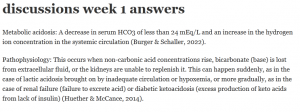discussions week 1 answers

Metabolic acidosis: A decrease in serum HCO3 of less than 24 mEq/L and an increase in the hydrogen ion concentration in the systemic circulation (Burger & Schaller, 2022).
Pathophysiology: This occurs when non-carbonic acid concentrations rise, bicarbonate (base) is lost from extracellular fluid, or the kidneys are unable to replenish it. This can happen suddenly, as in the case of lactic acidosis brought on by inadequate circulation or hypoxemia, or more gradually, as in the case of renal failure (failure to excrete acid) or diabetic ketoacidosis (excess production of keto acids from lack of insulin) (Huether & McCance, 2014).
Clinical manifestations: Alteration in the neurologic, respiratory, gastrointestinal, and cardiovascular systems are signs of metabolic acidosis. Initial symptoms of severe acidosis include lethargy and a headache, which can escalate to a coma. Respiratory compensation is indicated by deep, fast breathing (Kussmaul breaths). It’s typical to have anorexia, nausea, vomiting, diarrhea, and abdominal pain. Extreme acidosis may make it harder for the heart to contract normally and result in potentially fatal dysrhythmias (Huether & McCance, 2014).
Evaluation and treatment: Lab results, symptoms, and medical history are used to make the definitive diagnosis of metabolic acidosis. The results of the laboratory tests will reveal arterial blood pH below 7.35 and bicarbonate concentration below 24 mEq/L. A movement to the right can be seen in the oxyhemoglobin curve. For a buffering solution to be used effectively, the underlying issue must be identified. Administration is necessary to raise the pH to a safe level during severe acidosis (pH 7.1), especially if there is renal failure. Deficits in water and sodium must also be made up (Huether & McCance, 2014).
Metabolic alkalosis: An initial rise in serum bicarbonate, which causes a blood pH increase to >7.45 (Tinawi, 2021).
Pathophysiology: Increased bicarbonate concentration, which is often brought on by an excessive loss of metabolic acids. Prolonged vomiting, stomach suctioning, a high intake of bicarbonate, hyperaldosteronism with hypokalemia, and diuretic medication are all conditions that might lead to metabolic alkalosis (Huether & McCance, 2014).
Clinical Manifestations: Volume loss and electrolyte deficits are linked to several common symptoms including weakness, cramping, and overactive reflexes. Some people may have paresthesias, tetany, and seizures. To maximize carbon dioxide retention, respirations are shallow and sluggish. With severe alkalosis, disorientation and seizures happen. A potential issue is atrial tachycardia. As oxyhemoglobin’s dissociation decreases and the likelihood of dysrhythmias rises, the oxyhemoglobin curve shifts to the left (Huether & McCance, 2014).
Evaluation and treatment:A sodium chloride solution is necessary for the treatment of contraction alkalosis or hypochloremic alkalosis. As a result, HCO3 may be expelled as NaHCO3 in the urine and the renal impulse to increase ECF volume by holding Na+ is reduced. Potassium therapy treats alkalosis brought on by hypokalemia or hyperaldosteronism. The potassium reduces hydrogen loss from the distal tubule by causing hydrogen to migrate back into the ECF (Huether & McCance, 2014).